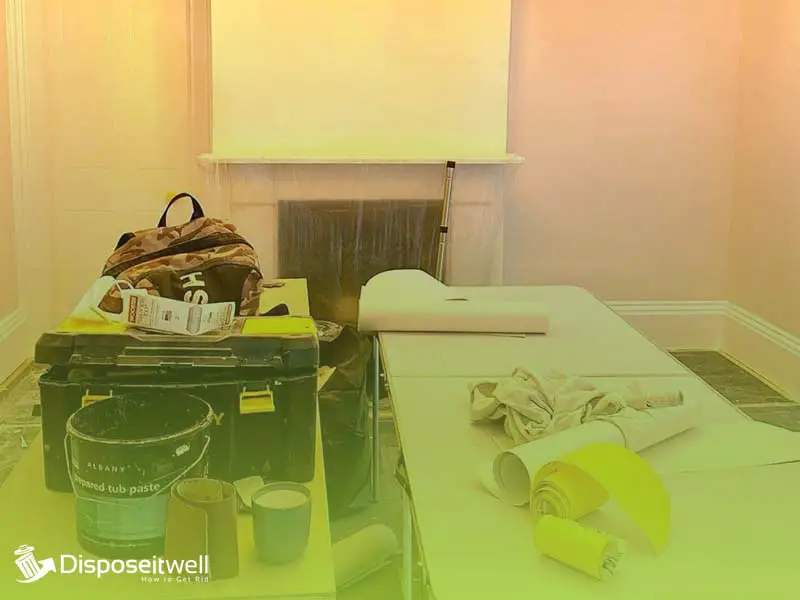Wallpaper paste is an essential part of the wallpaper installation process, but it can also be a hassle to dispose of. If you have recently finished a wallpaper project, you might be wondering how to safely and properly get rid of the leftover paste.
Did you know that most wallpaper paste is not biodegradable? That means it’s not just going to magically disappear on its own.
If you dump it down the drain or toss it in the trash, you’ll end up with clogged pipes and a miserable environment. Don’t worry, there are a couple of easy ways to dispose of wallpaper paste that won’t give you a headache.
Is Wallpaper Paste Hazardous?
Wallpaper paste can be hazardous if it contains volatile organic compounds. Many wallpaper adhesives contain formaldehyde, which is a volatile organic compound that has been linked to health problems. The National Cancer Institute has also linked formaldehyde to cancer.
The use of wallpaper paste requires safety precautions due to the presence of harmful materials such as ammonia, sulfur dioxide, and heavy metals.
How To Dispose Of Wallpaper Paste?
When it comes to disposing of wallpaper paste, there are two distinct paths to take:
Wet Wallpaper Paste
1. Remove as much of the wallpaper paste as possible using a putty knife and damp cloth.
2. Add a few drops of dish soap to a bucket of warm water and stir.
3. Dip a sponge into the soapy water and use it to scrub off any remaining paste.
4. Rinse the surface with a damp cloth to remove any soapy residue.
5. Discard the soapy water in an outside drain or toilet.
Dry wallpaper paste
1. Carefully scrape off as much of the paste as possible with a putty knife or other scraping tool.
2. Vacuum up any remaining paste particles using a vacuum cleaner with a hose attachment.
3. Place the vacuum contents in a plastic bag or container and seal them for disposal.
4. The dry paste can then be disposed of in the trash.
Can Wallpaper Paste Be Washed Down the Sink?

There is no point in washing wallpaper paste down the sink. It is made from starch, water, and other ingredients like glue, and it is thick, sticky, and designed to hold wallpaper firmly in place.
If washed down the sink, it will clog drains, cause drainage issues, and may eventually cause serious plumbing issues that will require expensive repairs.
What Can I Do With Leftover Wallpaper Paste?
Leftover wallpaper paste can be used to make a variety of craft and home repair projects. Here are some ideas for how to use it.
1. Create a Mosaic
Mix the leftover wallpaper paste with acrylic paints to create a colorful mosaic design. This is a great way to give an old piece of furniture, such as a table or dresser, a new look.
2. Fix Furniture
Use this adhesive to fill in cracks in furniture, countertops, or other surfaces. This can help to restore the integrity of the material and make the item look new.
3. Hang Wallpaper
By using leftover wallpaper paste, you can give any room a fresh makeover without having to purchase new wallpaper. Simply hang the wallpaper of your choice with the existing wallpaper paste and enjoy the new look.
4. Make a Decoupage
Decoupage is a great way to transform a piece of furniture or artwork. Simply mix the wallpaper paste with a variety of paper cutouts and apply it to your project.
5. Seal Envelopes
With the residue wallpaper paste, you can create the perfect seal for your envelopes. Just apply a thin layer to the envelope and press the flap down to make sure it’s nice and secure. Now no need to worry about your mail getting into the wrong hands.
How Long Can I Leave Wallpaper Paste in a Bucket?

The answer to this question is not a simple one as it depends on the type of wallpaper paste used. Regular wallpaper paste can be left in a bucket for up to 24- 48 hours, depending on the manufacturer’s instructions.
However, for the best results, it is always recommended to use the paste as soon as possible after mixing, as leaving the paste for too long can cause it to thicken, making it difficult to apply. Regardless of the type of paste used, always remember to cover the bucket with a lid or plastic wrap to prevent the paste from drying out.
Final Verdict
Now that you’ve been schooled on how to safely dispose of wallpaper paste, you can be proactive in preserving your home and the environment. Don’t forget to put on protective gear and obey the manufacturer’s guidelines.
Taking additional precautions will guarantee that no hazardous materials will be released into the environment when you throw away the paste. With the right knowledge, you can sleep soundly knowing that your wallpaper paste is being disposed of correctly.
Thank you for reading!

Gemma Alexander has an M.S. in urban horticulture and a backyard filled with native plants. After working in a genetics laboratory and at a landfill, she now writes about the environment and recycling topics.

